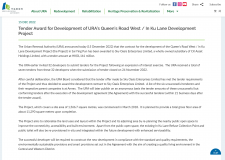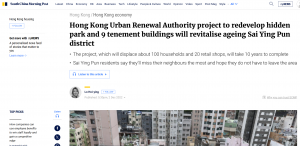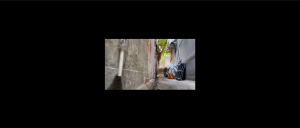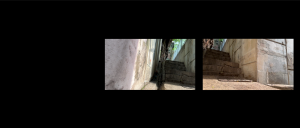Urban Threads: the alleyways and the connecting city
Introduction: the uniqueness of alleyways
The video’s keywords are “alleyway” and “the connecting city”. They reflect Hong Kong’s adaptation of its natural landscape and manual urban density. Hong Kong has a unique landscape compared to the city built on the plains and the high density of skyscrapers, so there is extreme demand for connectivity. Alleyways are a unique and effective method to connect different locations on the ground level. They act like urban threads, utilizing complex geographical conditions, connecting spaces, and providing small but convenient shortcuts among wide roads.
Specifically, the site is Kwok Hing Lane in Sai Ying Pun to express the theme through its unique physical features. For example, the alley has three branches, and these three paths start at the same place and turn in different directions but have the same endpoint. The three paths give the pedestrians different feelings. For instance, the path in the middle has multiple stairs, the path in the middle has a long slope, and the path on the right is twice as long and narrower than the other two. Therefore, although the directional distance from the start to the destination is only around 100 meters, the pedestrians can still have three completely different experiences.

the three routes shown in the video
However, the alleyways will be replaced in the coming decade. According to the Hong Kong Urban Renewal Authority, a redevelopment project in Sai Ying Pun will be finished around 2032 to improve the connectivity of this area and provide a better living experience for the residents who live in the old buildings. In other words, some alleys, like Kwok Hing Lane, will vanish with the redesign of Sai Ying Pun. This video documents this traditional and iconic connection method in Hong Kong.



Before the video: a deeper understanding of the site
Online resources and offline observations can bring different aspects of the alleyways. The government website systematically introduces the coverage of the redevelopment project in Sai Ying Pun. Digital newspapers such as South China Morning Post and RTHK bring the residents’ perspective to the story, showing they are pleased with the renewal program. Besides, reality observations of the site provide an immersive visual experience with trials of different speeds and angles. The above background information describes an alleyway with branches and complex routes but will positively embrace its vanishment. These features help to decide the tone of the video.
Before the video: film techniques to better convey the theme and features
Connectivity is the main theme that the video wants to express, and the film techniques are based on the theme and the site information research. First, using the cat/rat perspective and focusing on the corner of the alleyways can guide the audience’s visual focus to the alleyway itself and avoid the distraction of the surrounding buildings. Therefore, the camera’s movement (i.e., crab, track, pan, tilt) can be more exaggerated. The differences between the three alleyways are also comparable because of the consistency of the camera angle and filming subject.
Second, since the pedestrian has three choices to reach the destination from the same start, a parallel Montage can show the complex route simultaneously. The application of low camera angle, single focus, and Montage is to enlarge the residents’ daily experience to the audience.



As for lighting and color effects, the video keeps the original sunny condition, mapping a positive mood and echoing the positive feedback from residents in the interviews. In general, the filming techniques aim to obtain the feeling from a first-person perspective without voice-over.
After the video: the video and the city
Hong Kong is a highly connected city with an advanced pedestrian system. In Hong Kong, alleyways are shrunken public spaces, compromises of community open space in highly urbanized areas. Initially, alleyways should be an essential part of residents’ daily lives and keep them physically and mentally healthy (e.g., the hutong culture in old Beijing), but under the highly compressed urbanization of Hong Kong, many alleys are so narrow that they only retain their connecting function. This excessive compression of public space is not the will of residents but rather the mandatory planning of the hegemony at the top of the city’s social structure. As times change, alleyways will be gradually replaced on social significance and utility levels. This replacement is cheerful, not sad. This sentiment is also on full display in news interviews with residents. Although only one alleyway is presented in the video, tens of thousands of alleyways are winding through the city over the decades. After several years, these urban threads will gradually disappear, and there will be more humane and beautiful road facilities to take over their mission and contribute to this well-connected city.
Bibliography
Certeau, M. de. (1988). The practice of everyday life (S. Rendall, Trans.). University of California Press.
Christ, M. C., & Tieben, H. (2020). Magic Lanes: A placemaking approach for laneway spaces in Hong Kong. In M. Gibert-Flutre & H. Imai (Eds.), Asian Alleyways: An Urban Vernacular in Times of Globalization (pp. 181–210). Amsterdam University Press. https://doi.org/10.2307/j.ctv1b0fvwq.11
Fear, B. (2000). Architecture + film II. Wiley-Academy.
Joseph-Lester, J. (Ed.). (2020). Walking cities. / London (Second edition.). Routledge.
Koeck, R. (2013). Cine-scapes : cinematic spaces in architecture and cities. Routledge. https://doi.org/10.4324/9780203721186
Lo, H. (2022, December 2). Hong Kong Urban Renewal Authority project to redevelop hidden park and 9 tenement buildings will revitalise ageing Sai Ying Pun district [Review of Hong Kong Urban Renewal Authority project to redevelop hidden park and 9 tenement buildings will revitalise ageing Sai Ying Pun district]. South China Morning Post. https://www.scmp.com/news/hong-kong/hong-kong-economy/article/3201857/hong-kong-urban-renewal-authority-project-redevelop-hidden-park-and-9-tenement-buildings-will
Penz, F., & Thomas, M. (1997). Cinema & architecture : Méliès, Mallet-Stevens, multimedia. British Film Institute.
Prakash, G. (2010). Noir urbanisms: dystopic images of the modern city (1st ed., Vol. 3). Princeton University Press. https://doi.org/10.1515/9781400836628
RTHK. (2022, December 2). Revamp planned in Sai Ying Pun [Review of Revamp planned in Sai Ying Pun]. RTHK.HK. https://news.rthk.hk/rthk/en/component/k2/1678157-20221202.htm
Spottiswoode, R. (1950). Technique of the Film: 1. Analysis. In A Grammar of the Film: An Analysis of Film Technique (1st ed., pp. 113–196). University of California Press. https://doi.org/10.2307/jj.8085350.8
Urban Renewal Authority. (2022, December 15). Tender Award for Development of URA’s Queen’s Road West / In Ku Lane Development Project [Review of Tender Award for Development of URA’s Queen’s Road West / In Ku Lane Development Project]. Urban Renewal Authority. https://www.ura.org.hk/en/news-centre/press-releases/20221215
director/filmming/editor: Zhao Meijing
all the content are original
Zhao Meijing 3036126991